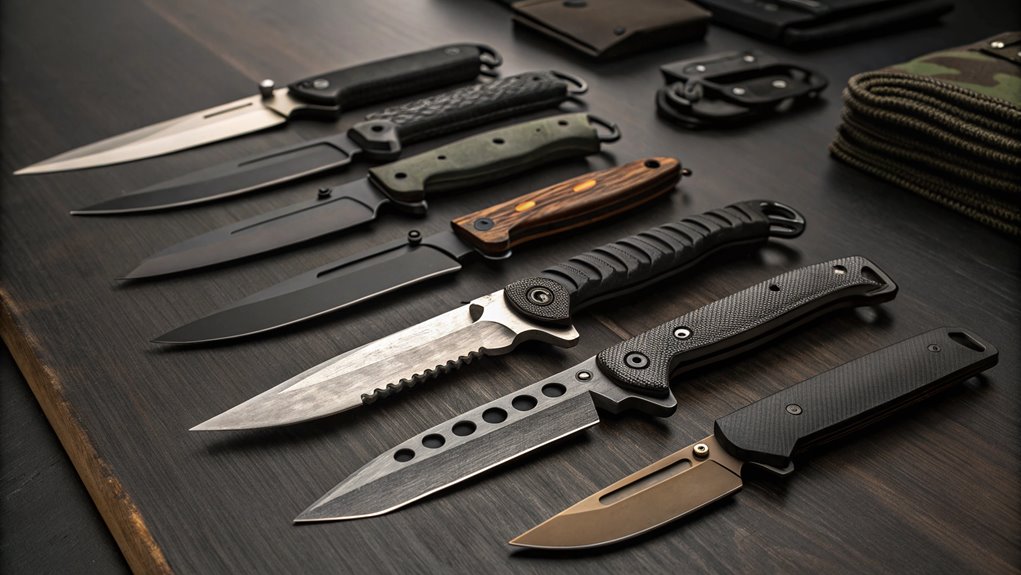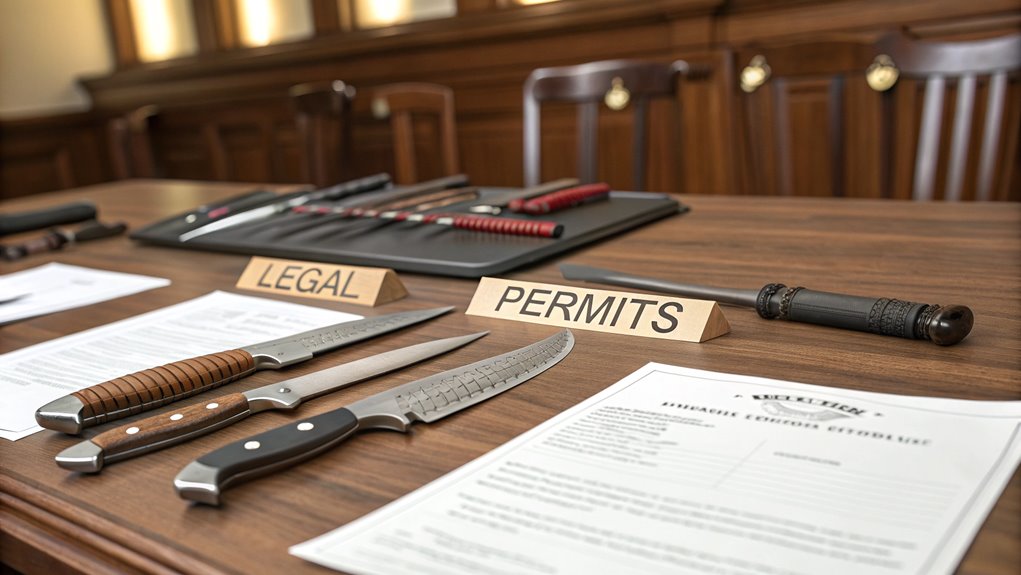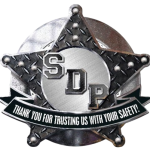Are you trying to figure out the different types of knives for self defense? You’ve got some solid options that can really boost your safety. Look for assisted open pocket knives, like the 8.5-inch model, which are easy to carry and quick to access. A blade between 3 and 7 inches offers a balance of control and intimidation. Just remember, laws about knife ownership vary, so check local regulations to avoid any trouble. It’s essential to know which types require permits, too. Carrying the right knife makes you feel empowered, ready to face potential threats, and if you want to nail down the specifics, just keep exploring.
Enhanced Personal Safety

Having a knife for self-defense can be a game changer when it comes to your personal safety. Not only can it serve as a solid deterrent against potential attackers, but it also helps you stay more aware of your surroundings, making you less vulnerable. Plus, just carrying a reliable self-defense tool can boost your confidence when facing threats, and that’s something we all could use! For those interested in purchasing self-defense knives, Self Defense Products LLC offers a variety of options, including the 8.5 Assisted Open Pocket Knife. One popular option is the Assisted Open Folding Pocket Knife with a grey handle and blue accents, which features a 3.25-inch blade made of 3CR13 steel.
Deterrent Against Potential Attackers
Carrying a knife for self-defense can act as a powerful deterrent against potential attackers. Just knowing you have a knife visible can make you feel more secure, and it might even discourage someone from trying to mess with you in the first place.
When an attacker spots your knife, they might think twice before approaching, knowing you’ve got a tool for self-defense tactics right at your side.
Here are three reasons why knife visibility can be so effective:
- Psychological Impact: A visible knife can send a clear message that you’re not an easy target. Attackers usually prefer victims who seem unprepared.
- Confidence Boost: Carrying a knife can give you a sense of empowerment. You’ll feel more in control of your safety, which can change how you carry yourself.
- Quick Access: If you need to defend yourself, having your knife handy means you won’t waste precious seconds fumbling around.
Improved Situational Awareness
Being aware of your surroundings can greatly enhance your personal safety, especially when you’re carrying a knife for self-defense.
Improved situational awareness is vital in any self-defense strategy. It helps you spot potential threats before they become real problems.
Here are three essential tips to boost your environmental awareness:
- Observe Your Environment: Keep an eye on the people and activities around you. Are there groups that seem suspicious? Are there exits or places to escape if needed?
- Trust Your Instincts: If something feels off, don’t ignore that gut feeling. It’s your brain’s way of telling you to pay attention and be cautious.
- Practice Mindfulness: Sometimes, we get lost in our phones or daydreams. Stay present! Focus on your surroundings so you can react quickly if something happens.
Increased Confidence in Threats
Increased confidence when evaluating potential threats can greatly enhance your personal safety. When you feel prepared, you’re less likely to panic in challenging situations. This mindset comes from understanding self-defense techniques and developing mental preparedness.
Here are three key ways to boost your confidence:
- Practice Regularly: Familiarize yourself with different self-defense techniques. The more you practice, the more natural it will feel to react in a real situation.
- Know Your Environment: Stay aware of your surroundings. Knowing where exits are, and which paths to avoid can help you feel more secure.
- Carry the Right Tools: Having a self-defense knife on hand gives you a sense of control. It’s not just a weapon; it’s a means of empowerment.
Being confident when facing potential threats not only helps you stay calm but also allows you to assess situations more effectively.
If you approach threats with a level head, you’re more likely to make smart decisions that can protect you. Remember, your safety matters, and taking steps to boost your confidence is essential for your personal well-being.
Legal Knife Ownership Requirements
Understanding legal knife ownership requirements is vital for anyone considering a knife for self-defense.
You’ve got to know that knife laws can differ from one state to another, and they can be pretty confusing. Some places allow you to carry certain knives openly, while others have strict self-defense regulations that limit what you can have.
For instance, switchblades might be banned in some areas, while others allow them as long as they’re in a specific size range.
It’s also important to know where you can carry your knife. Some public places, like schools and government buildings, might’ve rules against it.
If you’re caught with an illegal knife, you could face serious trouble, including fines or even jail time! Always do your homework to guarantee you’re following the rules in your area.
Consider that automatic knives, such as the Automatic Heavy Duty Knife, may have additional restrictions, so understanding your local laws is crucial.
Acquiring Necessary Permits

Often, you’ll need to acquire specific permits before legally carrying a knife for self-defense. The rules vary by state and city, so it’s essential to know the legal restrictions in your area. You might have to fill out a permit application or even go through a background check. It sounds tedious, but it’s all about keeping you and everyone else safe!
Here’s a quick guide to help you understand the process:
| Step | Details | Notes |
|---|---|---|
| Research Local Laws | Check your state and city laws | Some places have strict rules |
| Complete Permit Application | Gather necessary documents | Be prepared for fees |
| Undergo Background Check | May be required in some areas | Takes time, so plan ahead |
| Approval Wait Time | Can vary from days to months | Don’t rush; it’s worth it! |
Understanding these steps will help you navigate the permit process smoothly. Getting the right permits isn’t just a formality; it’s a significant part of ensuring you can defend yourself legally and responsibly. Stay informed, stay safe!
Blade Length and Weight
When it comes to selecting a knife for self-defense, the blade length and weight play essential roles in your overall effectiveness and comfort. You want a blade that feels right in your hand, so consider how different lengths and weights affect knife handling.
A shorter blade, around 3 to 4 inches, is often easier to control and less intimidating, making it ideal for close encounters. On the other hand, a longer blade, like 5 to 7 inches, offers more reach and can deliver powerful strikes, but it requires more skill to handle safely.
Weight matters too! A lighter knife is easier to carry and maneuver, which can be vital in a tense situation. However, a heavier knife might deliver more force and stability, allowing for stronger cuts.
Think about your own strength and preferences—what feels comfortable and manageable for you?
Ultimately, you should choose a knife that balances these blade characteristics with your personal ability to handle it effectively. Remember, the right knife can be a valuable tool for self-defense, but only if you’re confident in using it.
Answers to Common Questions
What Are the Best Knife Techniques for Self-Defense?
To master self-defense techniques, focus on blade angles and striking methods. You’ll want to practice slashing and thrusting motions while targeting vulnerable areas. Consistent training will improve your effectiveness and confidence in critical situations.
Can I Carry a Knife on Public Transportation?
You can carry a knife on public transportation, but you must check local legal restrictions and transportation policies first. Some areas have specific rules about knife sizes and types, so always verify before traveling.
How Do I Choose a Knife for My Skill Level?
When choosing a knife for your skill level, consider knife sizes that feel comfortable in your hand and blade shapes that match your intended use. Start with something manageable and gradually explore more advanced options as you improve.
What Materials Should My Self-Defense Knife Be Made Of?
Your knife should be made from the toughest steel types available, like high-carbon or stainless, ensuring durability. For blade designs, look for ones that offer versatility and efficiency, making your self-defense tool practically invincible.
Are Folding Knives Effective for Self-Defense Situations?
Folding knives can be effective in self-defense situations due to their compact size and portability. However, their locking mechanisms might fail under pressure, making them less reliable than fixed blades. You should weigh these advantages and disadvantages carefully.
Bottom Line
When it comes to self-defense, choosing the right knife can feel like picking the perfect tool for a job—it’s all about being prepared. Remember, safety isn’t just about having a weapon; it’s about understanding the laws, knowing how to use it wisely, and being aware of your surroundings. So, take the time to research and pick a knife that fits your needs, because your safety is worth more than a fleeting moment of hesitation. Stay sharp!




